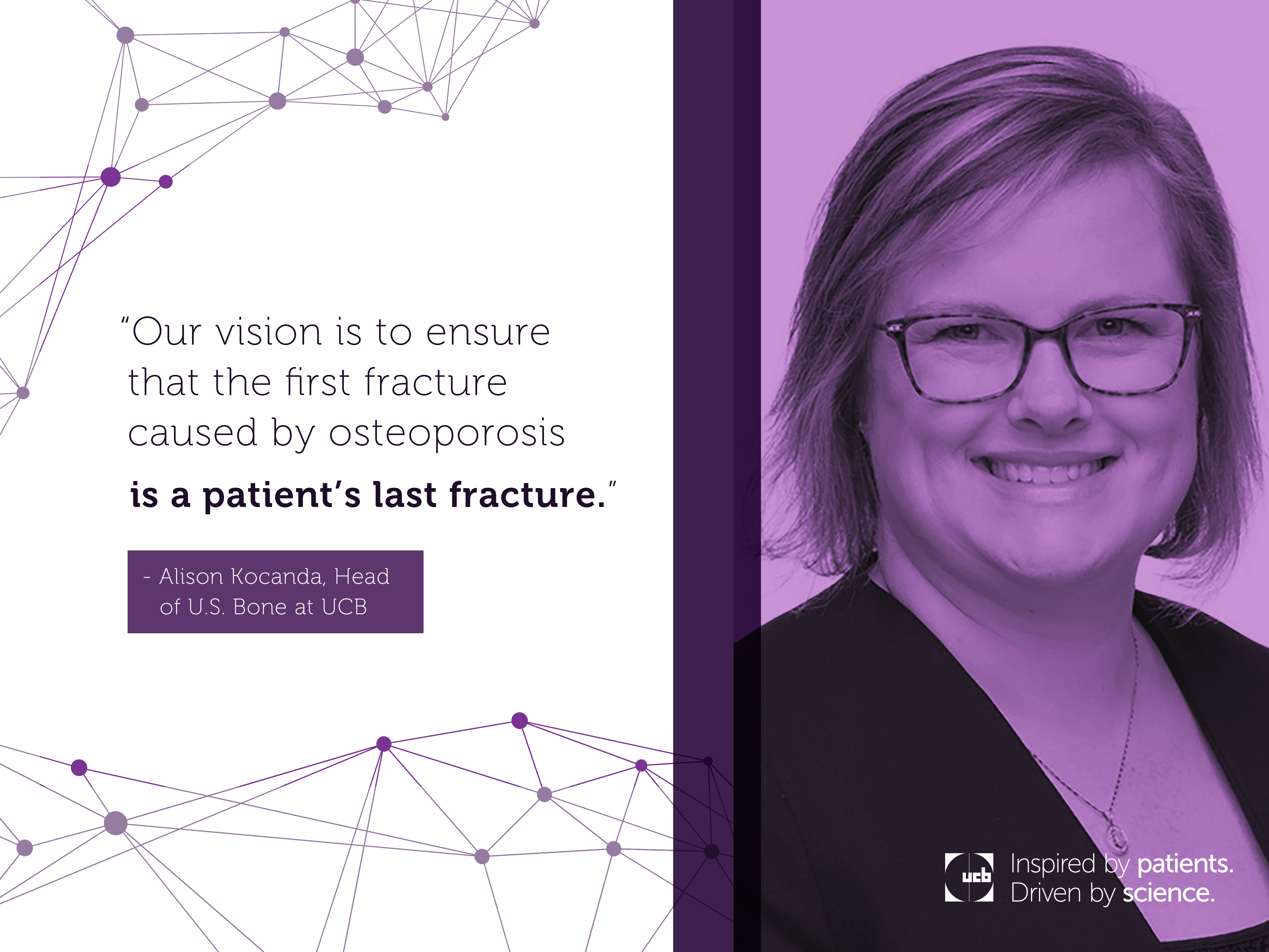
At UCB, we are using our passion and expertise to address gaps in post-fracture care to provide patients the support they need. This Osteoporosis Awareness Month, read from Alison Kocanda, Head of U.S. Bone, as she shares how UCB is supporting patients through education and resources.
For the more than 10 million Americans with osteoporosis, Osteoporosis Awareness Month is an opportunity to recognize the challenges of living with and managing the disease. At UCB, we believe that improving patient care and outcomes starts with increasing awareness and knowledge, particularly helping patients and the larger healthcare community understand the chronic nature and underlying risks of this disease. Our vision is to ensure that the first fracture caused by osteoporosis is a patient’s last fracture, focusing on the preventable secondary fracture that can hinder overall health and quality of life.
Osteoporosis reduces the quality and density of bones, making them weak, fragile and more prone to fracture. In many instances, patients will not know they have the disease until they experience their first fracture. After this first fracture, research* shows that 80% of people are neither diagnosed or treated for the condition, which increases their risk for a subsequent fracture. At UCB, we are using our passion and expertise to address these gaps in post-fracture care to provide patients the support they need.
Bolstered by our knowledge of population health and healthcare decision-making, we created a multi-faceted approach to better address the underlying risks for patients who have experienced a fragility fracture caused by osteoporosis. Collaboration is essential, and the intersection of our four foundational elements to close the care gap for patients enables us to take a holistic approach to their care:
1) Emphasize Fragility Fractures as a Public Health Priority
We have partnered with policy experts within the advocacy community to reinforce and improve existing policies that address some of the major gaps in treatment and care. Our support and collaboration with organizations like the National Osteoporosis Foundation has activated change and elevated awareness among the Senate Special Committee on Aging, United States Department of Health & Human Services (HHS) and other governmental bodies to make sustainable change for the patients we serve.
2) Reinforce the Clinical Importance of Fragility Fractures
As the population continues to age, the number of fragility and subsequent fractures are expected to rise. With 80% of osteoporosis patients in the U.S. being female, clinical guidelines and treatment options for post-menopausal women become even more important. UCB continues to address the needs of this population and deliver solutions to patients that reduce the risk of fracture.
3) Drive Adoption of Coordinated Care Models in the Health System
Over the last year, UCB helped more than 50 hospitals and healthcare systems implement new, evidence-based post-fracture care pathways in the U.S., providing more than 30,000 patients with access to care models that prioritize secondary fracture prevention. We believe that improving outcomes starts with the four “I’s":
- Identify individuals at risk of osteoporosis-related fractures
- Investigate, evaluate, assess and diagnose these patients
- Initiate appropriate treatment in patients who need therapy
- Integrate an interdisciplinary management approach
Our regional care teams are engaging with their health system stakeholders to discover opportunities to improve care coordination for patients after a fragility fracture. The goal is to continue to make an impact within healthcare systems nationally and globally, elevating the number of patients with access to evidence-based post-fracture care to prevent subsequent fractures caused by osteoporosis.
4) Provide Positive Patient Experiences
Everything we do at UCB ties back to patients. Many of the disease areas in our portfolio are chronic in nature, making the insights and feedback from patients with osteoporosis incredibly valuable across our entire pipeline. For example, patients have shared the importance of living independently as a component of their care plans. Recognizing this patient need, we engaged with Rebuilding Together, an organization that works with patients to improve their home environments and allow them to remain independent.
We must and will continue to work with clinicians, policy makers, advocates and patients to continue closing the gaps in osteoporosis diagnosis and treatment and make a lasting impact. At UCB, the health and safety of patients is and has always been our top priority. Now, more than ever, I am hopeful that our strategy and ability to adapt to today’s healthcare landscape will continue to improve outcomes for the patients we serve.
*UCB is a supporter of the National Osteoporosis Foundation and the National Bone Health Policy Institute.
Read the article on Linkedin
Choose Country
- Global Site – English
- Australia – English
- België – Engels
- Belgique – Anglais
- Brasil – Português
- България – Български
- Canada – English
- Canada – Français
- 中国 – 中文
- Česká Republika – Angličtina
- Danmark – Engelsk
- Deutschland – Deutsch
- France – Français
- España – Español
- Ελλάδα – Ελληνικά
- India – English
- Ireland – English
- Italia – Inglese
- 日本 – 日本語
- Казахстан – ағылшын тілі
- 한국 – 한국어
- Luxembourg – Anglais
- Luxemburg – Engels
- Magyarország – Angol
- México & Latinoamérica – Español
- Nederland – Engels
- New Zeeland – English
- Norge – Engelsk
- Österreich – Deutsch
- Polska – Polski
- Portugal – Inglês
- România – Engleză
- Россия – Русский
- Slovensko – Anglický
- Suomi – Englanti
- Sverige – Engelska
- Schweiz – Deutsch
- Suisse – Français
- Türkiye – Türkçe
- Україна – Англійська
- United Kingdom – English
- U.S.A. – English



